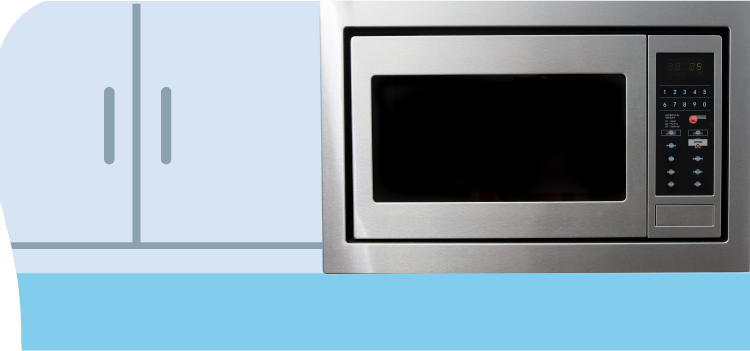How Many Watts Does a Microwave Use?
by Tyler Castle
7.2 min read

Microwaves are a staple in most kitchens, offering a quick and convenient way to heat food. But have you ever wondered how many watts a microwave uses and how to find them? The microwave watts your appliance uses can make all the difference with the efficiency of your model.
Understanding the wattage of your microwave not only helps you gauge its energy usage. We’ll explore how many watts a typical microwave uses, how to calculate its energy consumption, and how to find the watts in your microwave. Let’s jump into this interesting subject!
Key Points of This Article:
- Microwaves typically use between 600 and 1,700 watts, and higher wattage models cook food faster and more efficiently.
- A microwave around 1,000 watts is generally recommended, with lower wattage suitable for simple reheating and higher wattage better for full cooking tasks.
- You can find a microwave’s wattage on interior labels, exterior tags, or the user manual, and input watts show total electricity use while output watts show cooking power.
- Electricity cost depends on wattage, usage time, and local rates, and a 1,200 watt microwave used 15 minutes daily consumes about 0.30 kWh per day
How many watts does a microwave use?
On average, the wattage of a microwave can range from 600 watts to 1,700 watts.
How much watts a microwave uses depends on the model and size of the microwave, with smaller, more compact units typically using lower wattage and larger, high-powered models using more. Wattage directly correlates with power consumption and efficiency because it measures the amount of electrical power the microwave uses while operating.
Microwaves with high wattage will heat food quicker; the less time your unit is on, the more efficient it is. Finding the right balance between wattage and cooking needs is key to both efficient energy use and cost savings.
What is the best wattage for a microwave?
You might wonder how many watts should a microwave be for optimal performance? The wattage for a good microwave should be around 1,000 watts. This is the standard power you’ll need to cook most meals and recipes.
Determining how many watts a good microwave should be depends on you and your cooking needs. If you mainly use your microwave for simple tasks like reheating leftovers or making popcorn, a model with 600 to 800 watts should suffice. For more extensive cooking, such as defrosting meats or cooking full meals, a microwave with higher wattage—typically 1,000 to 1,200 watts—offers better performance.
How to find the watts on a microwave
How can you find the watts in a microwave? Usually, the exact wattage of your microwave can be found on the inside of your microwave door or on the outer frame of the cavity where you place your food.

Additionally, the wattage may be listed on a label or tag located on the back or side of the microwave. If you’re looking for how many watts your microwave will consume, you’ll want to look at the input watts rather than the output watts. Input watts refer to the total amount of electricity your microwave uses. While output watts refer to the cooking power delivered to the food.
Understanding the difference between input and output wattage. or in the user manual. If these sources are not available or unclear, checking the manufacturer’s website with your microwave’s model number can also provide the necessary information.
How much electricity does a microwave use?
Microwaves are generally considered to be energy-efficient appliances, but their electricity usage can vary based on their wattage and how long they are used. Electricity consumption is measured in kilowatt-hours (kWh), where one kilowatt-hour equals 1,000 watts used for one hour.
To determine how much electricity your microwave uses, you need to convert the wattage and usage time into kilowatt-hours.
For example, if your microwave is 1,000 watts and you use it for 10 minutes, the amount of electricity this microwave uses would equal 0.17 kWh.
Calculation of the energy consumption of a microwave
If you’re looking to calculate how much electricity a microwave uses, there’s a simple conversion on how to do so. For this example, let’s say your microwave runs at 1,200 watts. To find out exactly how many kilowatt hours your appliance will use, simply multiply your wattage by the amount of time you’re using your appliance.
So, for this example, let’s say you use your 1,200 watt microwave to heat up, defrost or cook meals for an average of 15 minutes a day. First, convert 15 minutes to hours, which is 0.25 hours (15 minutes ÷ 60 minutes per hour). Then, multiply the wattage by the time in hours (1,200 watts X 0.25 hours equaling 300 watt hours).
To convert this to kilowatt-hours, divide by 1,000 (kilowatt hours measure 1,000 watts per hour), by 300-watt hours. Therefore, your 1,200-watt microwave will consume approximately 0.30 kWh of energy per day if used consistently for 15 minutes each day.
Compared to other appliances in the home, a microwave has relatively low energy consumption.
How much does it cost to power a microwave?
The exact amount of how much it costs to power a microwave will vary based on several factors including your location, the rate of your energy plan, your energy plan type and your energy patterns.
On average, a microwave can cost around $0.86 per month at the U.S. average price for kilowatt hour.
Here’s how the cost of running a microwave in your home breaks down Using the average price of electricity in different U.S. states if you were to use your appliance for just 15 minutes per day:
Cost of Powering a Microwave in Different U.S. States
| Wattage | Pennsylvania (Average of 18.43 ¢/kWh)* | Illinois (Average of 17.59 ¢/kWh)* | Ohio (Average of 16.12 ¢/kWh* | Michigan (Average of 19.37 ¢/kWh)* |
|---|---|---|---|---|
| 1,000 | $0.031 | $0.029 | $0.027 | $0.032 |
| 1,200 | $0.037 | $0.035 | $0.032 | $0.039 |
| 1,700 | $0.052 | $0.050 | $0.046 | $0.055 |
Weekly Cost of Running a Microwave (15 minutes/day)
| Wattage | Pennsylvania (Average of 18.43 ¢/kWh)* | Illinois (Average of 17.59 ¢/kWh)* | Ohio (Average of 16.12 ¢/kWh* | Michigan (Average of 19.37 ¢/kWh)* |
|---|---|---|---|---|
| 1,000 | $0.32 | $0.31 | $0.28 | $0.34 |
| 1,200 | $0.39 | $0.38 | $0.34 | $0.41 |
| 1,700 | $0.55 | $0.52 | $0.48 | $0.58 |
Monthly Cost of Running a Microwave (15 minutes/day)
| Wattage | Pennsylvania (Average of 18.43 ¢/kWh)* | Illinois (Average of 17.59 ¢/kWh)* | Ohio (Average of 16.12 ¢/kWh* | Michigan (Average of 19.37 ¢/kWh)* |
|---|---|---|---|---|
| 1,000 | $1.38 | $1.32 | $1.21 | $1.45 |
| 1,200 | $1.66 | $1.58 | $1.45 | $1.74 |
| 1,700 | $2.35 | $2.24 | $2.06 | $2.47 |
Yearly Cost of Running a Microwave (15 minutes/day)
| Wattage | Pennsylvania (Average of 18.40 ¢/kWh)* | Illinois (Average of 17.59 ¢/kWh)* | Ohio (Average of 16.12¢/kWh* | Michigan (Average of 19.37 ¢/kWh)* |
|---|---|---|---|---|
| 1,000 | $16.79 | $16.05 | $14.71 | $17.67 |
| 1,200 | $20.25 | $19.26 | $17.65 | $21.20 |
| 1,700 | $28.55 | $27.27 | $24.99 | $30.07 |
*Averages are based off of the E.I.A’s stats from March 2025.
Factors that influence the energy consumption of microwave
While we’ve calculated the estimated energy consumption of a microwave, there are various factors that can influence your energy consumption:
Higher-wattage microwaves consume more electricity but cook food faster, while lower-wattage models use less energy but take longer.
- The more often you use your microwave, the more energy it consumes overall.
- Longer cooking times increase energy consumption.
- Larger amounts of food or denser items (like frozen meals) require more energy.
- Newer, energy-efficient models may consume less electricity than older or less efficient microwaves.
- Using lower power settings can reduce energy consumption.
FAQs
Is a higher-wattage microwave more energy-efficient?
A higher-wattage microwave is not necessarily more energy-efficient, but it can cook food faster, which may lead to lower overall energy consumption for individual tasks.
How can I reduce the energy consumption of my microwave?
To reduce the energy consumption of your microwave, consider these practices:
- Avoid using the microwave on full power if a lower setting will suffice.
- Covering food with a microwave-safe lid or wrap can trap steam, helping your food cook faster and using less energy.
- A clean microwave operates more efficiently.
- If your microwave has a standby mode, unplug it when not in use to prevent it from drawing power.
Can glass go in the microwave?
Yes, most types of glass can go in the microwave, but it’s important to ensure that the glass is labeled as “microwave-safe.” Regular glass, like tempered glass or heat-resistant glass (such as Pyrex), is generally safe for microwave use.
However, thin or decorative glassware, particularly those with metallic finishes, should not be used in the microwave.
Understanding the wattage of your microwave and how it impacts energy consumption is key to managing both your cooking efficiency and electricity costs. While microwaves generally have a lower energy footprint compared to other household appliances, choosing the right wattage for your needs and using your microwave efficiently can make a noticeable difference in your energy use.
There’s peace of mind in knowing you’ll pay the same monthly supply cost amount for your electricity or natural gas supply without any uncertainty — no matter what. Santanna’s Unlimited Energy option protects your bills from fluctuating supply charges no matter the changes in seasons. For over 35 years, Santanna has served customers in Illinois, Indiana, Pennsylvania, Michigan, and Ohio. Our mission is to provide innovative and cost-effective energy solutions that will help our customers achieve their energy goals.
Tyler is an experienced energy professional, having worked for Santanna Energy Services, for the past four years. He is passionate about renewable energy and believes that diversifying the energy grid is the key to a sustainable future. Tyler is dedicated to supplying consumers with the best possible energy solutions and works diligently to make sure that Santanna can deliver the highest quality service.







